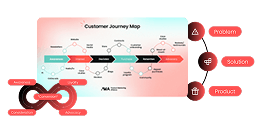In product marketing, every launch is an opportunity to strengthen the company's positioning, drive product adoption, and generate revenue.
However, not all new releases carry the same strategic weight. Without a solid prioritization framework, communication efforts become scattered, making it difficult to highlight competitive differentiators and overwhelming customers and stakeholders with disconnected information.
When multiple launches are treated with the same level of urgency, what should create impact turns into noise. Marketing and sales teams become disoriented, customer experience becomes fragmented, and valuable opportunities are lost. Without clear direction, product marketing risks becoming reactive, wasting time and resources on initiatives that do not generate significant value.
Prioritization does not mean neglecting features but ensuring that each launch receives the appropriate effort and visibility. A new product or module requires a robust go-to-market strategy, while smaller updates can be shared in a more focused way. A well-structured prioritization approach maximizes product adoption, optimizes communication channels, and strengthens the company's market narrative.
In this article, we address the challenges of lacking prioritization and explore strategies to ensure each initiative gets the attention it deserves. We also present an expanded version of Intercom’s prioritization framework, adding detailed criteria to assess the weight of each launch.
Our approach goes beyond customer impact and innovation, incorporating strategic factors such as revenue potential, retention, and competitive differentiation. If your goal is to increase the relevance of product marketing in your company and turn every launch into a success, keep reading.
Understanding the context
Understanding the situation of the product marketing team is an important first step in identifying and informing priorities. This quick roadmap of questions can help with that process:
- Where is the company or product in the life cycle?
- Is it in an explosive growth phase, is it mature, or is it a more of an adoption issue?
- What are the strategic goals for the business?
- Something like acquisition, retention and expansion goals or perhaps working to improve brand perceptions?
- What challenges exist within the function of product, sales and customer success?
- What are customers looking for or what is causing the most pain for the customers?
With a good understanding of these factors, it’s easier to ensure that prioritization stays in alignment with true business reasons and what is necessary in the market for real growth and success.
Understanding the pain points of lack of prioritization in product marketing launches
To achieve true effectiveness, having a product marketing strategy involves more than communicating new features; every launch must drive its desired impact as well.
Clearly, a prioritization framework is important to keep things organized and running smoothly, without messing up the overall customer experience or the business. If people are not focused on how priorities are communicated, it can lead to confusion, wasted time or resources, and slow differentiation in the market.
Here are some of the main pain points experienced by teams when there is no focus or prioritization on launches:
- Information overload for customers: Too-much communications can lead to customer overload, reduced engagement, or an increase in difficulty for customer substitution to the new features, etc.
- Dilution of message and solution value: By communicating conflicting updates (too many at one time), each one loses its distinct and important value and meaning.
- Misalignment between teams: Not having prioritization criteria can lead to all teams moving in different and conflicting directions, which leads to wasted work or product time, while also taking focus away from strategic initiatives. The product marketing team may be asked to launch "low priority" products or features. If no prioritization is established, it may become more challenging to explain why strategies were chosen.
- Inefficient use of resources: Time and effort may be wasted on lower-impact launches, while truly strategic features do not receive the attention they deserve.
- Difficulty in highlighting competitive differentiators: If everything seems equally urgent, the brand loses the opportunity to reinforce its positioning and showcase the value of its solutions in the market.
Intercom’s prioritization process
The Intercom model is widely used by product marketing managers (PMMs) to prioritize product announcements and has been validated by various technology and SaaS companies.
Its structure focuses on the combination of two main factors: the value that a new feature delivers to customers and the degree of innovation it represents. This approach enables a simple and efficient categorization, helping companies determine which launches deserve greater communication efforts.
However, the model we are proposing expands this framework by offering more detailed criteria for defining the weight of each launch. In addition to considering customer impact and innovation, our approach incorporates strategic aspects such as revenue generation potential, retention impact, and competitive differentiation.
This provides professionals with a more granular structure, allowing for more precise prioritization and stronger alignment between the teams involved in the go-to-market process.
For more details on Intercom’s original model, refer to this article.
Diving deeper into Intercom’s model
This model, widely adopted by SaaS companies, categorizes product launches based on two main axes: the value delivered to customers and the degree of innovation of the feature.
How it works
Product launches are classified into four quadrants:
- P1: Extremely high customer value and highly innovative. Requires high-impact campaigns.
- P2: High customer value but with lower innovation. Communication focuses on immediate benefits and adoption.
- P2: Highly innovative but without direct customer impact. Focus on competitive positioning and awareness.
- P3: Low value and low innovation. Internal communication or documentation may be sufficient.
Why use it?
This model is well suited for businesses that require a straightforward, effective framework for quickly classifying and communicating new launches.
This framework frees up the time of product marketers to spend more time investing in initiatives that will result in true business growth and differentiation. By deciding the strategic categorization of launches, you're enabling teams to allocate resources more effectively, thus allocating visibility to the right campaigns, for the right amount of impact.
This model also simplifies decision-making as it drives teams to consider whether actions they want to take result in the most value to customers and therefore help position the brand competitively in the market.
When there is power in a well-thought-out communication framework, every launch can be an incredible opportunity to drive engagement, or value, or adoption, or retention – achieving maximum results for business, and contribution to ongoing success.
Launch prioritization criteria – beyond Intercom’s framework
I recommend developing a more comprehensive approach by adding more detail to how we assess the relevance of each launch.
In addition to looking at customer impact and innovation, we include some necessary strategic components that will support the decision-making process.
For product marketing launches to deliver the desired impact, we should operate using a prioritization model that steers efforts toward initiatives that create value for the company and its customers.
A clear prioritization structure will allow product marketing to better prioritize their actions to demonstrate alignment to allocate and redirect resources and messaging to the company’s strategic objectives.
Key questions to support launch prioritization
- Is it a new product or feature? → Launches that will have an immediate impact on a company’s core objectives should get the most attention.
- Is it an enhancement with material value? → If the updating work requires considerable effort to communicate to customers, it should get special attention.
- Will it attract new users? → Features creating new audiences should be elevated.
- Will it drive increased revenue from existing users? → Improving monetization within existing customers can be a tremendous strategic differentiator.
- Will it decrease churn? → Releases that help reduce cancellations and retention should have the greatest prominence.
- Will it increase engagement of the product? → Features that drive continuous use will strengthen a customer’s relationship with a brand.
- Is it an innovation or a competitive differentiator? → If the launch places the company ahead of competitors, this could be the deciding factor for priority.
- How many customers will it impact? → The relevance of the launch can be measured on the breadth of customers impacted – either it serves a small portion or the majority of the customers.
Launches that meet a greater number of criteria will be indicated as P1 and P2, while launches that do not meet most criteria will receive a P3 priority.
This approach gives a good baseline for determining where a launch might fit into the experience, enabling easier alignment with the team and other areas of the business.
By using these criteria, professionals will be more informed to make more intelligent decisions about where to allocate their time to maximize launches that drive growth and the value proposition for the company.
How to implement in practice
Here are several options to leverage these criteria when evaluating a product launch:
- Use quantified and qualitative metrics: Always pair quantitative data (adoption rates, customer lifetime value) with qualitative customer data and competitor data. This establishes a holistic view of each launch's impact potential.
- Align with company goals: Determine if the launch aligns with a company's strategic objectives (increased revenue, improved retention, differentiation). This will support product marketing initiatives focused on meeting the company's strategic objectives.
- Utilize a scoring model: Create a weighted scoring model for each launch based on the key criteria (revenue potential, retention impact, differentiation). For example, define revenue potential as 1-5 and determine a weighted average (and priority level) based on the three factors.
- Perform feasibility pings of metrical tests: Perform some kind of impact analysis before the launch (historically, or some kind of market tests – or beta programs, or test groups). This should bring some increased capacity to estimate impact arguably more realistically – a.k.a., gauge expected impact on revenue and retention and competitive space.
- Monitoring the launch: Once launched, baseline monitoring of the initiative and how the product or feature is influencing the measures. This information can be used to iterate on prioritized future launches, and ensure on-going optimization.
Example of priority classification
Below, we present a table illustrating how features can be classified according to the established criteria:
Following these criteria allows professionals to make more strategic decisions, focusing efforts on launches that truly drive growth and strengthen the company's value proposition. This ensures more efficient resource management and communication that is better aligned with organizational goals.
Alignment of product marketing actions for each launch
Once the launches have been prioritized, a product marketing professional needs to have a clear idea of what will be done for each priority level. This serves to set expectations and ensure that stakeholders are fully aligned on what product marketing will (and will not) need to do in the go-to-market process.
The exact initiatives will vary from company to company; some products may require stronger positioning while others need to put more emphasis on sales enablement. The chart below is one suggestion but can and should be adjusted to meet each company's reality and needs.
This structure guides the PMM’s actions according to the impact of each launch, allowing efforts to be strategically directed to maximize adoption and product success in the market.
Alignment of communication channels by priority
After defining product marketing initiatives for each launch, it's essential to select the most suitable channels to communicate each announcement. While product marketing plays a strategic role in defining these channels, the execution of communications is usually carried out by other marketing teams.
Therefore, building strong relationships with these professionals is crucial to ensuring greater influence in decision-making and increasing the chances of the launch receiving the necessary visibility.
Additionally, the choice of channels should consider the impact and relevance of the new feature. Below is a suggested use of communication channels based on prioritization, utilizing the criteria established with the team and stakeholders.
Other product marketing launch prioritization frameworks
Prioritizing product launches is one of the most strategic dilemmas for PMMs. Choosing which features, products, or updates to prioritize is not a decision made lightly since these decisions can affect product adoption, market position and high-level company resources.
To assist PMMs in their decision-making, PMMs have developed and implemented a variety of frameworks on an ad-hoc basis. Each framework offers a different way to define a product or feature based on one or more factors, such as the impact it will have on customers, strategy or complexity of execution.
Below are some of the more commonly used frameworks for launch prioritization in product marketing.
1. RICE (Reach, Impact, Confidence, Effort)
Overview: Developed by Intercom for product roadmap prioritization, but widely used in product marketing to define the communication effort for each launch (Intercom, 2018).
How it works: Each launch is evaluated based on four criteria:
- Reach: How many customers will be impacted?
- Impact: How important is this update for users?
- Confidence: How certain are we about the expected results?
- Effort: What level of effort is required for the launch?
The final score is calculated by dividing the total impact by the effort, generating a score that helps rank priorities.
Why use it: Useful for PMMs who need to balance impact and effort when planning launch communications.
Reference: Intercom. (2018). The RICE scoring model: How to prioritize product ideas. Intercom Blog.
2. ICE Score (Impact, Confidence, Ease)
Overview: Similar to the RICE model but simplified for faster decision-making.
How it works: Launches are evaluated based on three factors:
- Impact: How much can this initiative improve key metrics like retention or engagement?
- Confidence: How certain are we that this launch will achieve the expected resul
- Ease: How easy is it to implement and communicate this update?
Each criterion receives a score from 1 to 10, and the final average helps define launch priority.
Why use it: Ideal for teams that need a quick and practical framework for making decisions.
Reference: Adapted from Intercom. (2019). Using the ICE framework to prioritize your ideas. Intercom Blog.
3. MoSCoW (Must-Have, Should-Have, Could-Have, Won’t-Have)
Overview: Commonly used in product development, this method also helps define the level of priority for communicating each launch (Clegg, 2017).
How it works:
- Must-Have: Critical launches that require maximum visibility.
- Should-Have: Important for customers but can be communicated with less intensity.
- Could-Have: Secondary launches that may receive limited promotion.
- Won’t-Have: Incremental improvements that can be documented but do not require significant marketing efforts.
Why use it: Useful for PMMs who need a simple and collaborative model to define priorities alongside other teams.
Reference: Clegg, M. (2017). MoSCoW method: Prioritizing requirements.
Conclusion
Prioritization in product marketing relates to more than just operational efficiency – it is a requirement for ensuring each launch achieves the expected returns, utilizes resources efficiently, and enhances the company's positioning.
A thoughtful, organized framework enables professionals to make more strategic choices, ensuring that they are putting the effort into initiatives that really provide value to the business and its customers.
We advanced Intercom's framework into a model that provides more detail in defining the importance of each launch initiative. In addition to assessing customer impact and the amount of change involved in innovations; we introduced other critical strategic factors, including revenue potential, retention impact, and differentiation from the competition.
This additional detail enables a more precise classification, a common understanding across teams, and ensures initiatives are placed and measured.
By adopting a clearly defined process of prioritization, the product marketing manager becomes a valuable driver of company's growth, by driving adoption of the product and the company's place in the market.


















 Follow us on LinkedIn
Follow us on LinkedIn




.svg)
Start the conversation
Become a member of Product Marketing Alliance to start commenting.
Sign up now